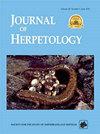暴露于捕食者线索会影响变形后幼年蛙极光的运动行为吗?
IF 0.8
4区 生物学
Q3 ZOOLOGY
引用次数: 0
摘要
摘要在生命早期接触捕食者会改变个体发育过程中的行为和身体特征。这对双相两栖动物物种来说很重要,因为幼年的运动行为可以通过幼虫环境的遗留效应和陆地栖息地非生物条件的直接影响来塑造。我们探讨了水生捕食者线索暴露、幼年形态和非生物陆地条件对后变质北方红腿蛙(Rana aurora)运动行为的影响。我们使用半自然封闭跑道和粉末追踪分析相结合的方法,量化了水生捕食者线索的遗留效应和基质条件对个体运动行为的直接影响。我们发现了水生条件的潜在影响,因此暴露在小龙虾中的个体在变态时具有更大的相对身体条件,并且所有暴露在捕食者中的个体相对于对照都具有更长的身体长度。陆地条件是形成运动行为的主导因素。在跑道运动分析过程中,在干燥土壤和低湿度条件下,个体条件运动位移可能比在高湿度潮湿条件下更大。对于夜间粉末追踪分析,个体在温暖的温度下更有可能有更大的路径距离,而在凉爽干燥的条件下路径不那么曲折。形态上较大的个体仅在粉末追踪分析期间移动了较大的距离。我们观察到水生捕食者暴露对幼年形态的潜在影响;然而,这些变化与直接环境条件在塑造运动行为中的相对重要性之间的关系尚不清楚。我们的研究结果证明了水生和陆地环境在塑造幼年两栖动物运动方面的相互关联性。本文章由计算机程序翻译,如有差异,请以英文原文为准。
Does Exposure to Predator Cues Influence Movement Behavior of Postmetamorphic Juvenile Rana aurora?
Abstract. Exposure to predators during early life stages can alter behavioral and physical traits during ontogeny. This is important for biphasic amphibian species because juvenile movement behavior can be shaped by carry-over effects of the larval environment and direct effects of abiotic conditions in terrestrial habitats. We explored the interaction of aquatic predator cue exposure, juvenile morphology, and abiotic terrestrial conditions on the movement behavior of postmetamorphic Northern Red-legged Frogs (Rana aurora). We quantified carry-over effects of aquatic predator cues and direct effects of substrate conditions on individual movement behavior using a combination of seminatural enclosed runways and powder tracking assays. We found a latent effect of aquatic condition, such that crayfish-exposed individuals had greater relative body condition at metamorphosis, and all predator-exposed individuals had larger body lengths relative to controls. Terrestrial conditions were the dominant factor shaping movement behavior. During runway movement assays, individual conditional movement displacement was likely greater in dry soil and low humidity conditions than in moist conditions with high humidity. For nocturnal powder tracking assays, individuals were more likely to have greater path distances during warmer temperatures, whereas paths were less meandering in cooler, dry conditions. Morphologically larger individuals moved greater distances only during the powder tracking assays. We observed latent effects of aquatic predator exposure on juvenile morphology; however, the relationship between these changes and the relative importance of direct environmental conditions in shaping movement behavior is unclear. Our results demonstrate the interconnected nature of aquatic and terrestrial environments in shaping the movement of juvenile amphibians.
求助全文
通过发布文献求助,成功后即可免费获取论文全文。
去求助
来源期刊

Journal of Herpetology
生物-动物学
CiteScore
1.60
自引率
0.00%
发文量
45
审稿时长
6 months
期刊介绍:
The Journal of Herpetology accepts manuscripts on all aspects on the biology of amphibians and reptiles including their behavior, conservation, ecology, morphology, physiology, and systematics, as well as herpetological education. We encourage authors to submit manuscripts that are data-driven and rigorous tests of hypotheses, or provide thorough descriptions of novel taxa (living or fossil). Topics may address theoretical issues in a thoughtful, quantitative way. Reviews and policy papers that provide new insight on the herpetological sciences are also welcome, but they must be more than simple literature reviews. These papers must have a central focus that propose a new argument for understanding a concept or a new approach for answering a question or solving a problem. Focus sections that combine papers on related topics are normally determined by the Editors. Publication in the Long-Term Perspectives section is by invitation only. Papers on captive breeding, new techniques or sampling methods, anecdotal or isolated natural history observations, geographic range extensions, and essays should be submitted to our sister journal, Herpetological Review.
 求助内容:
求助内容: 应助结果提醒方式:
应助结果提醒方式:


